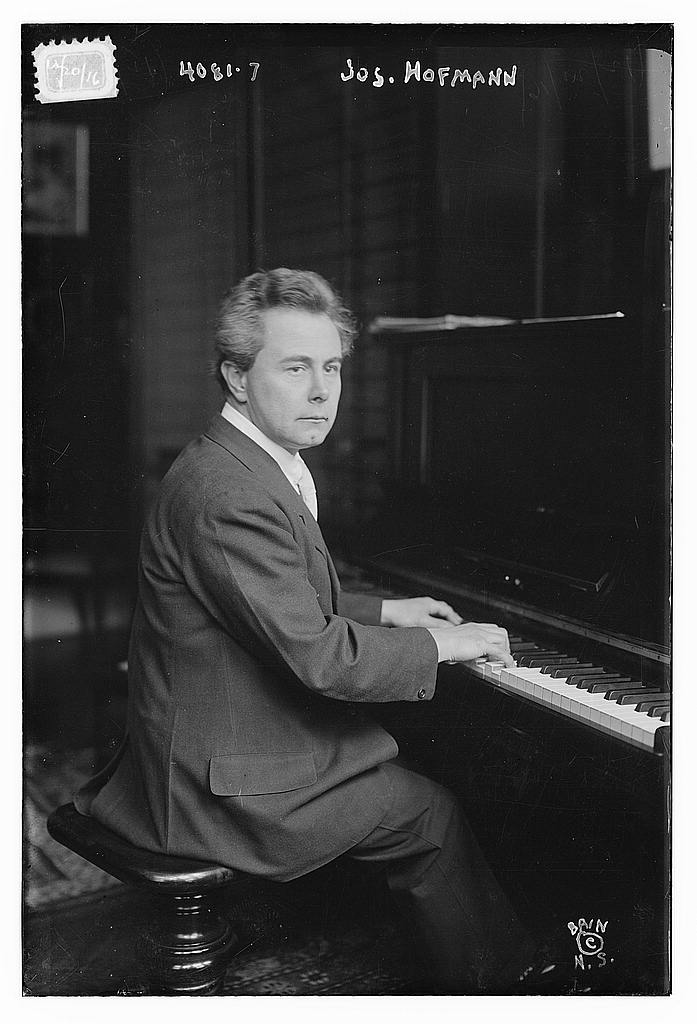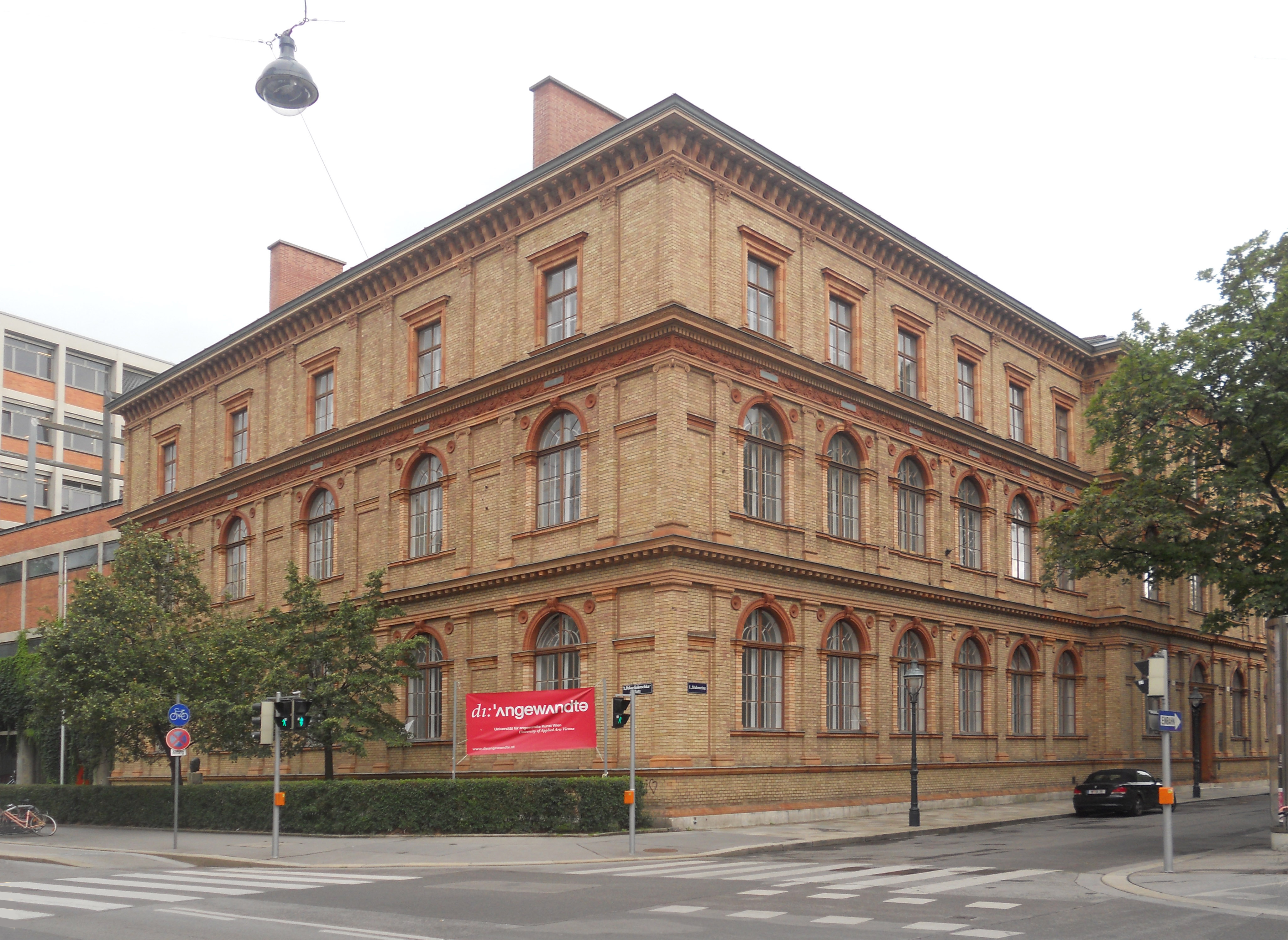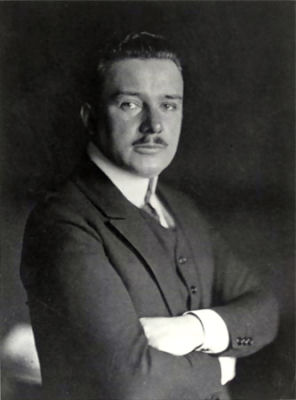|
Josef Hoffmann
Josef Hoffmann (15 December 1870 – 7 May 1956) was an Austrian- Moravian architect and designer. He was among the founders of Vienna Secession and co-establisher of the Wiener Werkstätte. His most famous architectural work is the Stoclet Palace, in Brussels, (1905–1911) a pioneering work of Modern Architecture, Art Deco and peak of Vienna Secession architecture. Biography Early life and education Hoffmann was born in Pirnitz / Brtnice, Moravia (now part of the Czech Republic), Austria-Hungary. His father was modestly wealthy, the co-owner of a textile factory, and mayor of the small town. His father encouraged him to become a lawyer or a civil servant, and sent him to a prestigious upper school, but he was very unhappy there. He later described his school years as "a shame and a torture which poisoned my youth and left me with a feeling of inferiority which has lasted until this day." In 1887 he transferred instead to the Higher School of Arts and Crafts State i ... [...More Info...] [...Related Items...] OR: [Wikipedia] [Google] [Baidu] |
Josef Hofmann
Josef Casimir Hofmann (originally Józef Kazimierz Hofmann; January 20, 1876February 16, 1957) was a Polish-American pianist, composer, music teacher, and inventor. Biography Josef Hofmann was born in Podgórze (a district of Kraków), in Austro-Hungarian Galicia (present-day Poland) in 1876. His father was the composer, conductor and pianist Kazimierz Hofmann, and his mother the singer Matylda Pindelska. He had an older sister – Zofia Wanda (born June 11, 1874, also in Krakow). Throughout their childhood, their father, Kazimierz, was married to Aniela Teofila ''née'' Kwiecińska (born on January 3, 1843, in Warsaw), who, after moving to Warsaw in 1878 with her husband, died there on October 12, 1885, entry 1392. Then the next year Kazimierz Mikołaj Hofmann married on June 17, 1886, Matylda Franciszka Pindelska - the mother of his children, (daughter of Wincenty and Eleonora ''née'' Wyszkowska, b. in 1851 in Kraków) in the Holy Cross Basilica in Warszawa. In order to ... [...More Info...] [...Related Items...] OR: [Wikipedia] [Google] [Baidu] |
Czech Republic
The Czech Republic, or simply Czechia, is a landlocked country in Central Europe. Historically known as Bohemia, it is bordered by Austria to the south, Germany to the west, Poland to the northeast, and Slovakia to the southeast. The Czech Republic has a hilly landscape that covers an area of with a mostly temperate continental and oceanic climate. The capital and largest city is Prague; other major cities and urban areas include Brno, Ostrava, Plzeň and Liberec. The Duchy of Bohemia was founded in the late 9th century under Great Moravia. It was formally recognized as an Imperial State of the Holy Roman Empire in 1002 and became a kingdom in 1198. Following the Battle of Mohács in 1526, the whole Crown of Bohemia was gradually integrated into the Habsburg monarchy. The Protestant Bohemian Revolt led to the Thirty Years' War. After the Battle of White Mountain, the Habsburgs consolidated their rule. With the dissolution of the Holy Empire in 1806, the Cro ... [...More Info...] [...Related Items...] OR: [Wikipedia] [Google] [Baidu] |
University Of Applied Arts Vienna
The University of Applied Arts Vienna (german: Universität für angewandte Kunst Wien, or informally just ''Die Angewandte'') is an arts university and institution of higher education in Vienna, the capital of Austria. It has had university status since 1970. History The predecessor of the ''Angewandte'' was founded in 1863 as the ''k. k. Kunstgewerbeschule'' (Vienna School of Arts and Crafts), following the example of the South Kensington Museum in London, now the Victoria & Albert Museum, to set up a place of advanced education for designers and craftsmen with the Arts and Crafts School in Vienna. It was closely associated with the ''Österreichischen Museums für Kunst und Industrie'' (Imperial Royal Austrian Museum of Art and Industry, today known as the MAK). It was the first school of its kind on the continent. In 1941 it became an institution of higher education. 1941-45 it was called "Reichshochschule fuer angewandte Kunst", and in 1948 was taken over by the Austrian s ... [...More Info...] [...Related Items...] OR: [Wikipedia] [Google] [Baidu] |
Kunstgewerbeschule
A Kunstgewerbeschule (English: ''School of Arts and Crafts'' or S''chool of Applied Arts'') was a type of vocational arts school that existed in German-speaking countries from the mid-19th century. The term Werkkunstschule was also used for these schools. From the 1920s and after World War II, most of them either merged into universities or closed, although some continued until the 1970s. Students generally started at these schools from the ages of 16 to 20 years old, although sometimes as young as 14, and undertook a four-year course, in which they were given a general education and also learnt specific arts and craft skills such as weaving, metalwork, painting, sculpting, etc. Some of the most well known artists of the period had been Kunstgewerbeschule students, including Anni Albers, Peter Behrens, René Burri, Otto Dix, Karl Duldig, Horst P. Horst, Gustav Klimt, Oskar Kokoschka, Egon Schiele and Oskar Schlemmer. Many students accepted into the renowned Bauhaus art sch ... [...More Info...] [...Related Items...] OR: [Wikipedia] [Google] [Baidu] |
Gable
A gable is the generally triangular portion of a wall between the edges of intersecting roof pitches. The shape of the gable and how it is detailed depends on the structural system used, which reflects climate, material availability, and aesthetic concerns. The term gable wall or gable end more commonly refers to the entire wall, including the gable and the wall below it. Some types of roof do not have a gable (for example hip roofs do not). One common type of roof with gables, the gable roof, is named after its prominent gables. A parapet made of a series of curves (Dutch gable) or horizontal steps (crow-stepped gable) may hide the diagonal lines of the roof. Gable ends of more recent buildings are often treated in the same way as the Classic pediment form. But unlike Classical structures, which operate through trabeation, the gable ends of many buildings are actually bearing-wall structures. Gable style is also used in the design of fabric structures, with varying degree ... [...More Info...] [...Related Items...] OR: [Wikipedia] [Google] [Baidu] |
Secession Building
The Secession Building (german: Secessionsgebäude) is an exhibition hall in Vienna, Austria. It was completed in 1898 by Joseph Maria Olbrich as an architectural manifesto for the Vienna Secession, a group of rebel artists that seceded from the long-established fine art institution. Description The building features the Beethoven Frieze by Gustav Klimt, one of the most widely recognized artworks of Secession style (a branch of Art Nouveau, also known as Jugendstil in Germany and Nordic countries). The building was financed by Karl Wittgenstein,Monk, ''Ludwig Wittgenstein: The Duty of Genius'': p.8 the father of Ludwig Wittgenstein. The motto of the Secessionist movement is written above the entrance of the pavilion: "To every age its art, to every art its freedom" (german: Der Zeit ihre Kunst. Der Kunst ihre Freiheit). Below this is a sculpture of three gorgons representing painting, sculpture, and architecture. The building has been selected to figure on the national side o ... [...More Info...] [...Related Items...] OR: [Wikipedia] [Google] [Baidu] |
Gustav Klimt
Gustav Klimt (July 14, 1862 – February 6, 1918) was an Austrian symbolist painter and one of the most prominent members of the Vienna Secession movement. Klimt is noted for his paintings, murals, sketches, and other objets d'art. Klimt's primary subject was the female body, and his works are marked by a frank eroticism. Amongst his figurative works, which include allegories and portraits, he painted landscapes. Among the artists of the Vienna Secession, Klimt was the most influenced by Japanese art and its methods. Early in his career, he was a successful painter of architectural decorations in a conventional manner. As he began to develop a more personal style, his work was the subject of controversy that culminated when the paintings he completed around 1900 for the ceiling of the Great Hall of the University of Vienna were criticized as pornographic. He subsequently accepted no more public commissions, but achieved a new success with the paintings of his "golden phase", ... [...More Info...] [...Related Items...] OR: [Wikipedia] [Google] [Baidu] |
Carl Otto Czeschka
Carl Otto Czeschka (22 October 1878, Vienna – 30 July, 1960, Hamburg) was an Austrian painter and graphic designer associated with the Wiener Werkstätte. Life Carl Otto Czeschka was half Bohemian and half Moravian origin. His father Wenzel Czeschka (''Vaclav Češka'', 1845–1915) was a master carpenter; and his mother Mathilde Hafner (1853–1883), working as a seamstress and embroiderer. Carl Otto Czeschka raised in Vienna under very poor background. He lived in the Zinckgasse 6, , , Rudolfsheim-Fünfhaus.or today's Neumayrgasse, Ottakring He worked intensely as a designer and book illustrator, making designs for many books, leaflets, programs, placards, etc. He was a friend of Gustav Klimt. His best known book is an art edition of the German tale "The Nibelungs" (Die Nibelungen), full in the Sezesion style that was predominant at his time. Further reading * Stasny, Peter.Czeschka, Carl Otto. In Grove Art Online. Oxford Art Online, (accessed January 9, 20 ... [...More Info...] [...Related Items...] OR: [Wikipedia] [Google] [Baidu] |
Koloman Moser
Koloman Moser (; 30 March 1868 – 18 October 1918) was an Austrian artist who exerted considerable influence on twentieth-century graphic art. He was one of the foremost artists of the Vienna Secession movement and a co-founder of Wiener Werkstätte. Moser designed a wide array of art works, including books and graphic works from postage stamps to magazine vignettes; fashion; stained glass windows, porcelains and ceramics, blown glass, tableware, silver, jewelry, and furniture. Biography Moser was born in Vienna in 1868 to parents Josef and Thresia Moser (née Hirsch); he was the oldest of three siblings. studied at the Wiener Akademie and the Kunstgewerbeschule, where he also taught from 1899. Moser's designs in architecture, furniture, jewellery, graphics, and tapestries helped characterise the work of this era. He drew upon the clean lines and repetitive motifs of classical Greek and Roman art and architecture in reaction to the Baroque decadence of his turn-of-the-centur ... [...More Info...] [...Related Items...] OR: [Wikipedia] [Google] [Baidu] |
Joseph Maria Olbrich
Joseph Maria Olbrich (22 December 1867 – 8 August 1908) was an Austrian architect and one of the Vienna Secession founders. Early life Olbrich was born in Opava, Austrian Silesia (now Czech Republic), the third child of Edmund and Aloisia Olbrich. He had two sisters, who died before he was born, and two younger brothers, John and Edmund. His father was a prosperous confectioner and wax manufacturer who also owned a brick works, where Olbrich's interest in the construction industry has its early origin. Career Olbrich studied architecture at the University of Applied Arts Vienna (''Wiener Staatsgewerbeschule'') and the Academy of Fine Arts Vienna, where he won several prizes. These included the Prix de Rome, for which he traveled in Italy and North Africa. In 1893, he started working for Otto Wagner, the Austrian architect, and probably did the detailed construction for most of Wagner's Wiener Stadtbahn (Metropolitan Railway) buildings. In 1897, Gustav Klimt, Olbrich, Jos ... [...More Info...] [...Related Items...] OR: [Wikipedia] [Google] [Baidu] |
Otto Wagner
Otto Koloman Wagner (; 13 July 1841 – 11 April 1918) was an Austrian architect, furniture designer and urban planner. He was a leading member of the Vienna Secession movement of architecture, founded in 1897, and the broader Art Nouveau movement. Many of his works are found in his native city of Vienna, and illustrate the rapid evolution of architecture during the period. His early works were inspired by classical architecture. By mid-1890s, he had already designed several buildings in what became known as the Vienna Secession style. Beginning in 1898, with his designs of Vienna Metro stations, his style became floral and Art Nouveau, with decoration by Koloman Moser. His later works, 1906 until his death in 1918, had geometric forms and minimal ornament, clearly expressing their function. They are considered predecessors to modern architecture. Education and early career Wagner was born in 1841 in Penzing, a district in Vienna. He was the son of Suzanne (née von Helf ... [...More Info...] [...Related Items...] OR: [Wikipedia] [Google] [Baidu] |


.ajb.jpg)




